How To Fillet A Fish?
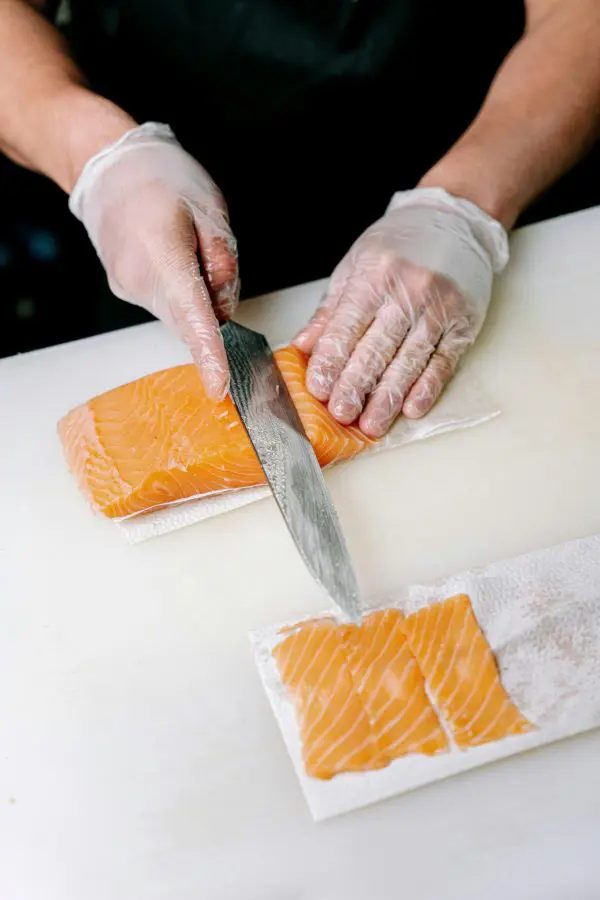
This post may contain affiliate links. If you make a purchase through links on our site, we may earn a commission.
Nothing beats the deep happiness of filleting your own fish, but only if you have done it before. While beginners might find it challenging at first, the process becomes easier with the right guidance. Whether you are filleting with a fresh catch or store-bought fish, you'll need just a few basic tools, patience, and proper guidance.
The good news is knowing how to fillet properly lets you enjoy boneless beautifully cut pieces of meat perfect for cooking. This guide breaks down the process into simple steps and with these steps, you'll be able to prepare fish confidently and safely in your own kitchen.
Essential Tools For Filleting Fish
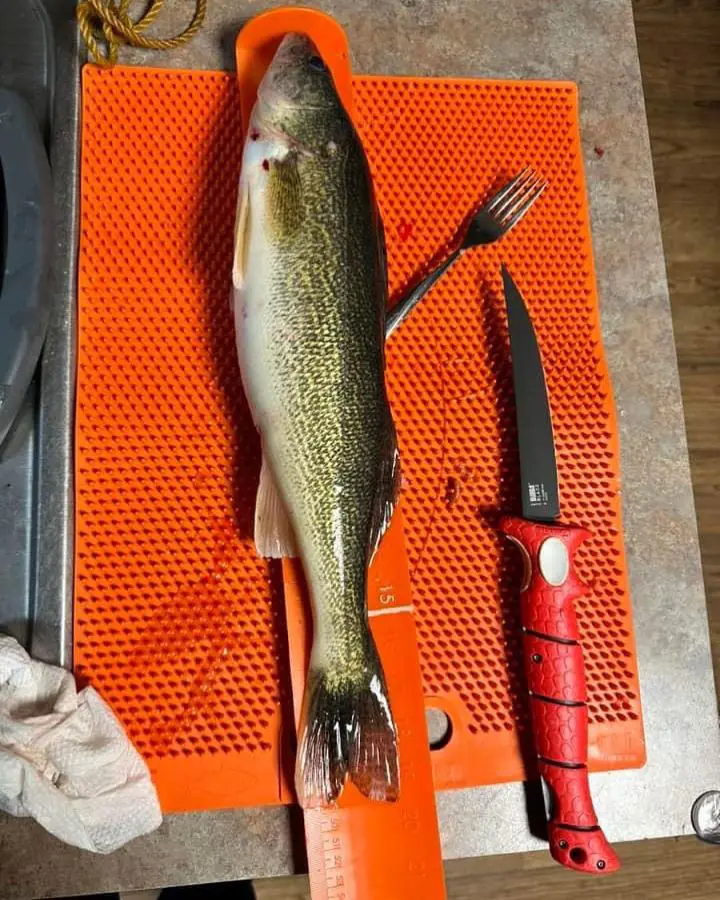
Before exploring the essential tools, let's start by learning to choose the right fish. The fish is the main ingredient; if it's not fresh, it can ruin the entire experience. Thus, choosing the right fish is crucial. When selecting a fish fillet, consider these factors:
- Look for bright red grills and clear eyes. The flesh should feel firm and not mushy.
- Likewise, familiarize yourself with different species. The most common options include salmon, trout, and bass.
After choosing the right fish, let's start to collect the vitals tools to fillet it,
- A Good Fillet Knife: This is the main tool. Basically, fillet knives range from 6 to 9 inches in length. This provides the flexibility to make clean cuts along the backbone while minimizing waste. If you don't have a fillet knife, a boning knife can serve as a suitable alternative, especially for larger fish.
- Cutting Board: Get a sturdy plastic one with grooves around the edges to catch the liquid. Wood boards are beautiful but they can harbor bacteria from fish, and you definitely don't want that smell sticking around!
- Small Needle-Nose Pliers: When filleting fish, it is obvious you may encounter pin bones, especially in species like rockfish. A small pair of needle-nose pliers can help you easily remove these bones without damaging the fillet. Simply, run your fingers over the flesh to locate them and gently pull them out with the help of pliers.
- Fish Scaler: Sure, you can use a spoon, but a dedicated scaler makes the job much quicker and less messy.
- Kitchen Shears: These are super handy for trimming fins and cutting through small bones. Way safer than trying to hack through them with a knife.
- Fish Skin Remover (Optional): If you fillet fish often, this tool makes removing skin a breeze. But honestly, your fillet knife can do the job just fine with practice.
- Gloves (Optional): Especially good when you're learning. Better safe than sorry (those fillet knives are sharp).
- Nutcracker or Oyster Knife (optional): If you're working with shellfish or need to crack shells, these tools are essential for safety and efficiency.
Additional Tips
- Keep your knife sharp- a dull knife is actually more dangerous
- Clean your tools right after use because the fish smell is stubborn
- Start with easier fish like trout before tackling something like salmon
Step-By-Step Guide To Filleting A Fish
After collecting and choosing the right fish, let's fillet our fish.
Initial Preparation Steps
- Rinse the fish to remove slime under cold running water
- Pat it dry with paper towels
- Place it on your clean cutting board
- Remove scales if necessary (work from tail to head)
- Set up your workspace with all tools within easy reach
- Make sure your cutting board is clean and secure
1. Scaling the Fish (Optional)

Scaling is not mandatory, but it is advisable. Especially, when the fish has a large scale, proper scaling makes filleting easier. You can scale with the help of a fish scaler or the back of a knife. Try this: Scale down from the tail end of the fish towards the head.
2. Making the Initial Cut
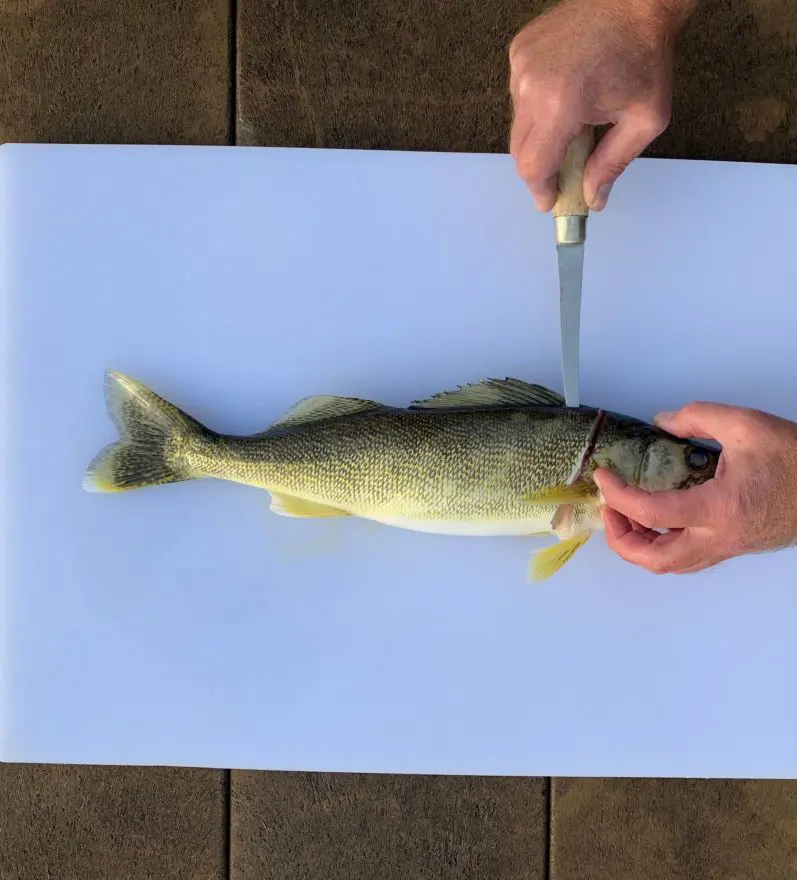
- Place the fish on its side with the head facing you.
- Make a diagonal cut (the knife enters at a 45-degree angle) behind the pectoral fin down to the spine. This cut should be deep enough to feel contact with the backbone but not cut through it.
3. Cutting Along the Backbone
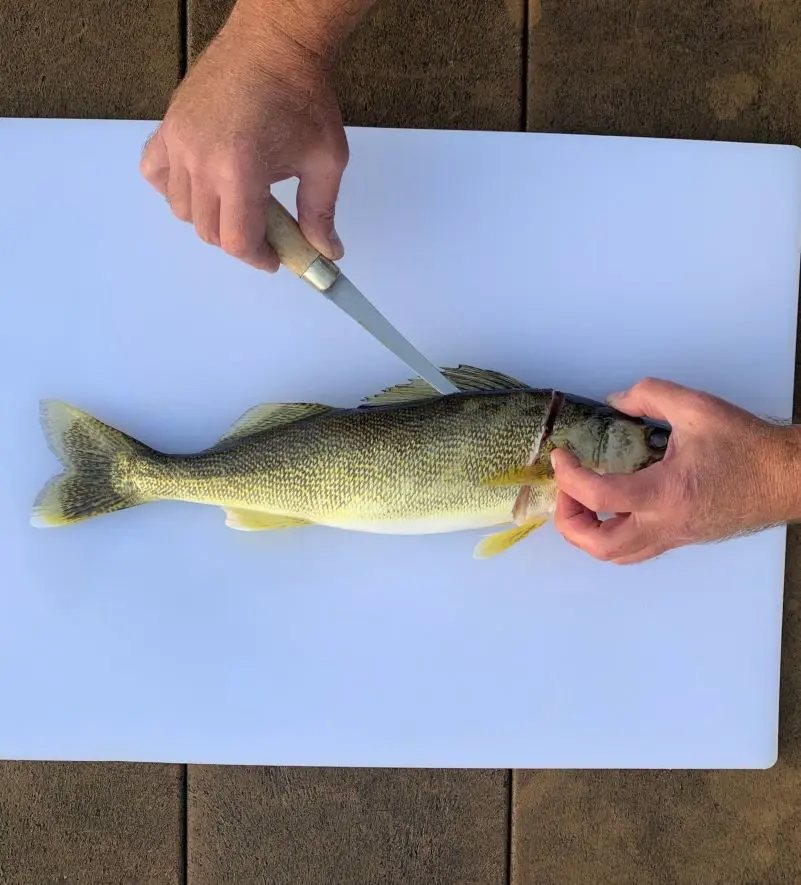
- Insert the tip of your knife into the initial cut and angle it toward the tail.
- Carefully glide your knife along the backbone, feeling for ribs as you go. Maintain a shallow angle to avoid cutting too deep.
4. Completing the Cut
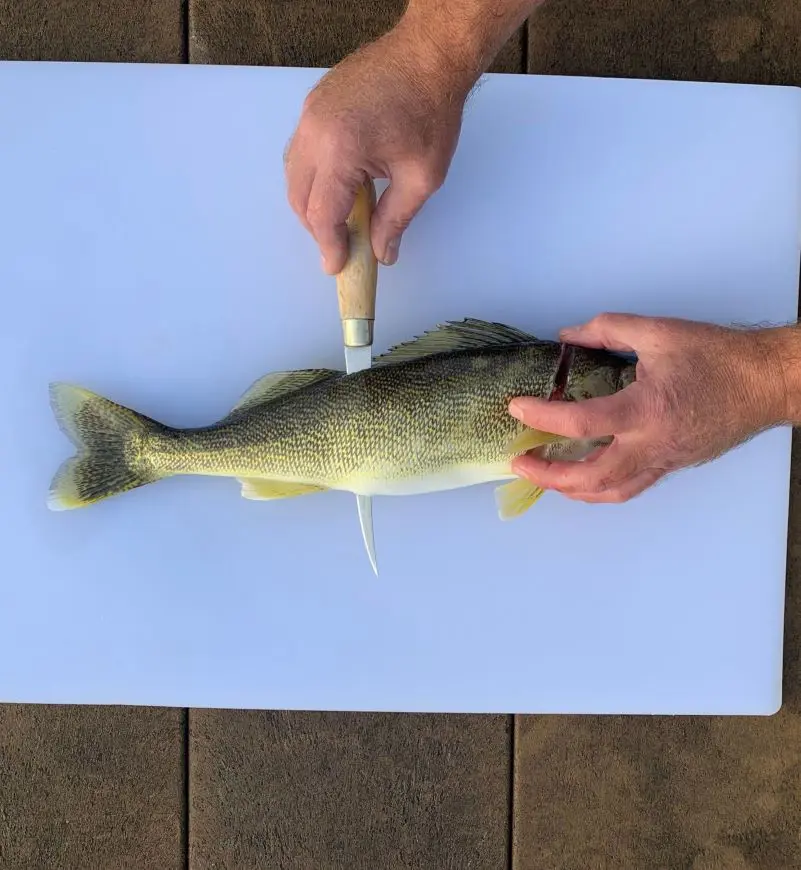
- Once you reach just past the dorsal fin, angle your knife down toward the belly, ensuring it exits above the anal fin.
- With one smooth motion, slide your knife toward the tail until it exits completely, creating a flap of fillet.
5. Removing Ribs
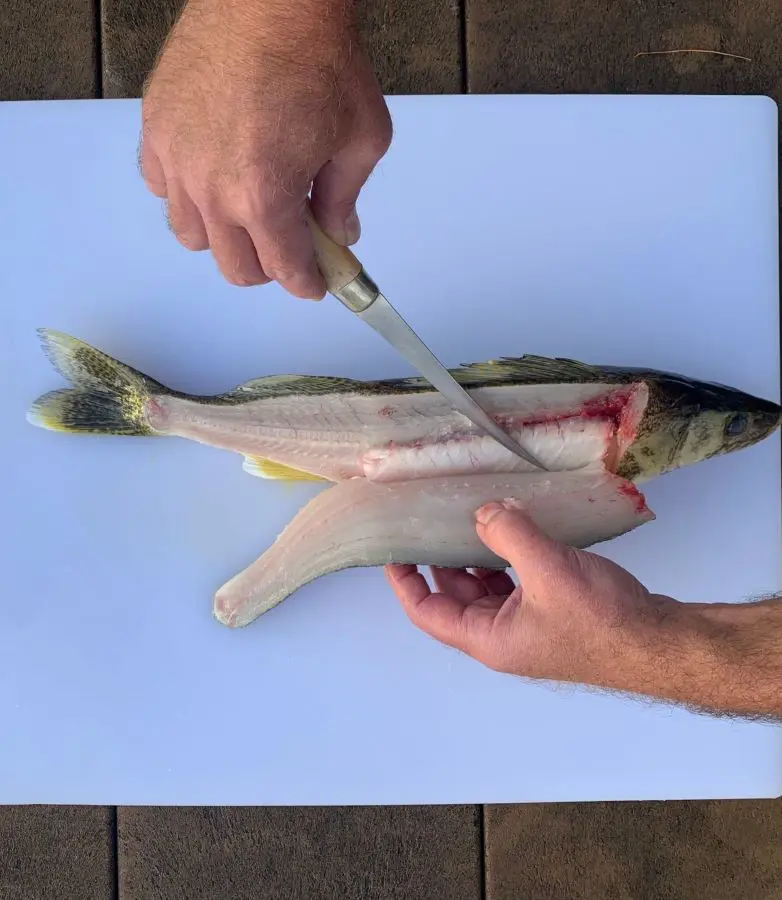
- Reinsert your knife at the junction between your initial cut and along the back.
- Follow along the ribs carefully, lifting as you cut to separate them from the fillet without damaging it.
6. Flipping and Repeating
- Once one side is complete, flip the fish over and repeat the same from steps 2-5 on the other side.
- You should now have two fillets separated from the skeleton.
Skinning Your Fillets (Optional)
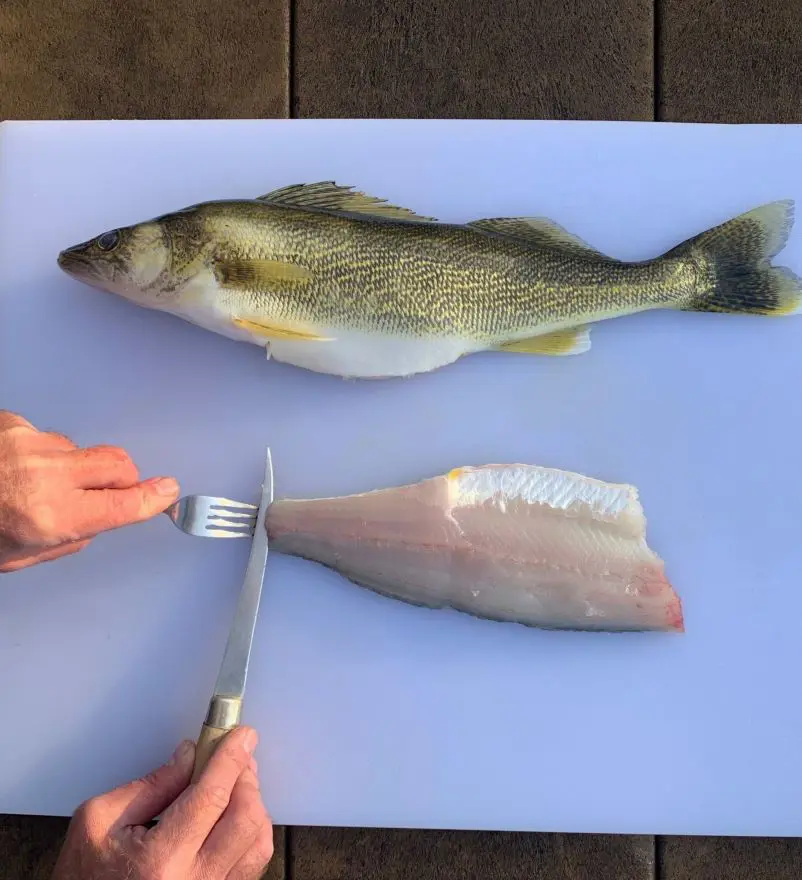
If you prefer skinless fillets:
- Place each fillet skin-side down on your cutting board
- At the tail end, make a small cut between the skin and the flesh
- Hold onto the skin tightly with a fork or fingernails while pulling it away from you as you slide your knife along, separating it from the meat.
- Clean off any remaining silver skin
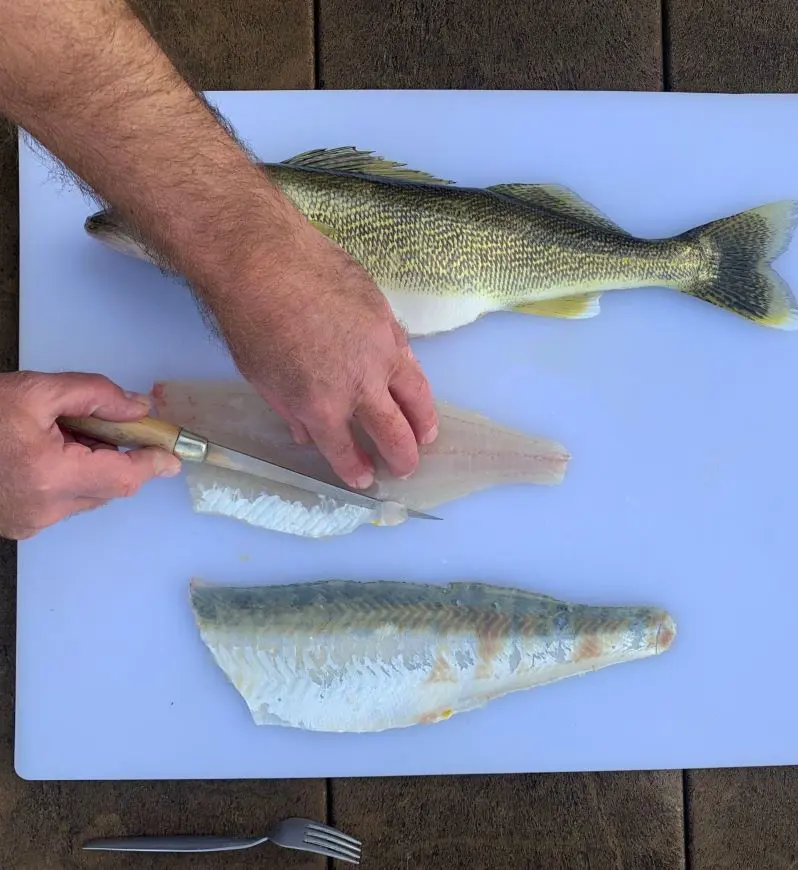
Trimming Your Fillets
After removing skin (if desired), trim any excess fat or dark meat from your fillets for better flavor and presentation.
Removing Pin Bones
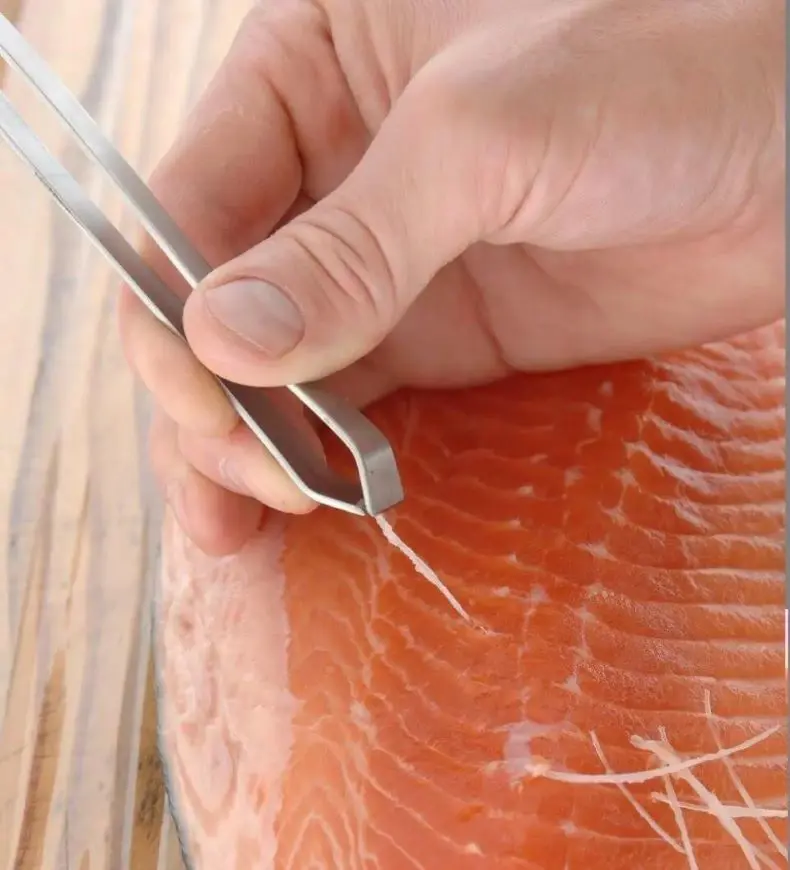
Most fish have small pin bones running along their length:
- Run your fingers along each fillet to locate these bones.
- Use tweezers or small needle-nose pliers to gently pull them out
Additional Tips For Perfect Fish Fillets
To precisely fillet your fish remember these things:
- Use gentle strokes: When you are slicing along the backbone, avoid sawing or pressing too hard. Gentle, even strokes create cleaner cuts.
- Keep the Fish Cold: Colder fish are easier to handle and reduce the risk of tearing the meat.
- Maintain a Sharp Knife: A sharp knife is essential for clean fillets. If your knife starts to dull, sharpen it before continuing.
Common Mistakes To Avoid
Sticking the fish to the filleting board is great, but beginners often make errors that can lower the quality of the fillet and the overall experience. Here we have described several types of mistakes that are worth avoiding during filleting.
- Starting with a Dull Knife: This is likely the most common mistake we all make. Using a blunt knife not only makes the process more difficult but also risks damaging the fish. A sharp knife is important to ensure clean cuts and helps prevent tearing the fish's flesh. So, always make sure your knife is well-sharpened before you start filleting.
- Not Cleaning the Fish Properly: Before you even think about filleting, make sure your fish is properly scaled and gutted. Sometimes we get eager and skip this step, but those leftover scales can really mess up your knife work and end up in the fillet. Nobody wants a mouthful of scales.
- Not Understanding Fish Anatomy: The main mistake many people make is neglecting to learn fish anatomy before filleting. It is important to know where the bones, fins, and other related parts are, as this helps you make clean cuts without harming the meat. Thus, it will be easy if you spend time understanding the particular fish you're working with.
- Cutting Too Deep: Another mistake most people make is slicing the fish too often and too deep, a mistake that leaves any fillets inexperienced or hard to detach from the bones. It's best to keep close to the bones and cut through the meat but not too closely to the bone.
- Bruising the Fish: Improper handling can bruise the fish, which directly affects its texture and taste. That's why be gentle when handling the fish, and avoid pressing down too hard or using excessive force during filleting.
- Not Scaling Properly: If you choose to scale your fish before filleting, ensure that you do it thoroughly. Keep in mind that inadequate scaling can lead to scales mixing with the flesh, resulting in an unpleasant texture in your fillets. Use a scaler or a spoon with light pressure to avoid bruising.
- Rushing the Process: Filleting requires patience and attention to detail. Rushing through it can lead to mistakes such as missing bones or uneven cuts. Take your time to ensure each step is done correctly for better results.
- Ignoring Bone Removal: After filleting, it's essential to check for any remaining bones in the fillet. Missing bones can pose a choking hazard when cooking or serving fish. Thus, don't take any risk. Use your fingers to feel for bones or tweezers or pliers to remove them carefully.
- Failing to Practice Proper Technique: Many beginners do not practice proper techniques for holding the fish or angling their knife correctly while cutting. Remember, proper grip and angle are vital for making accurate cuts along the bone structure without damaging meat.
How To Store Fillet Fish?
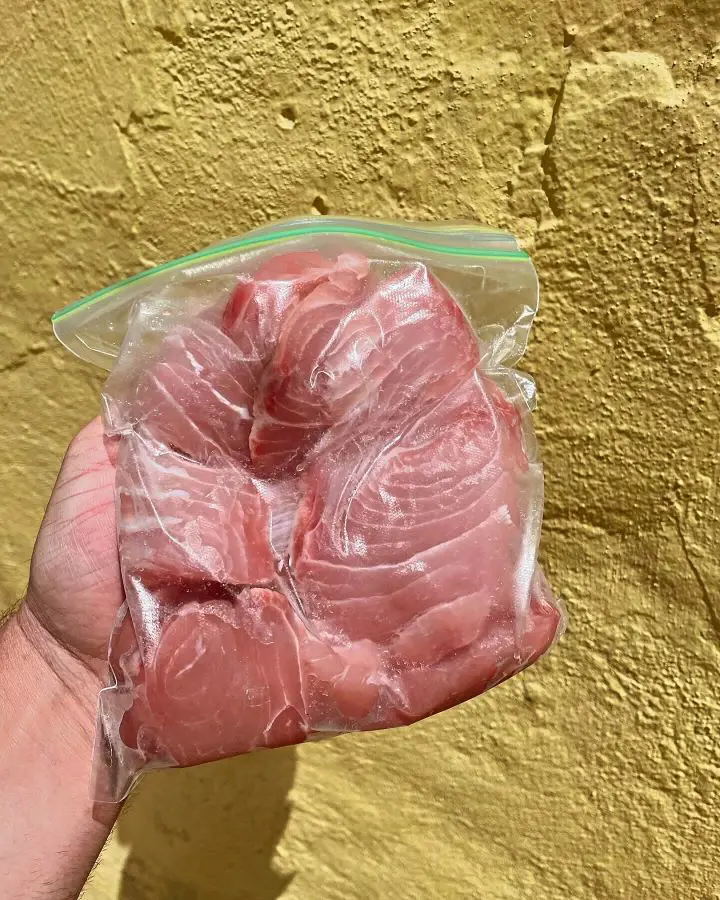
If you are not planning to eat it soon and want to store it properly. Then, follow these steps, as it will keep your fillets fresh and tasty.
Preparation Before Storage
- Clean the Fish: Rinse your fish fillets in cold seawater if possible. Avoid using freshwater, as it can make the fillets mushy due to osmosis.
- Dry Thoroughly: Use paper towels to pat the fillets fry. This step is crucial because moisture can lead to spoilage.
Storing in the Refrigerator
- Use Ice or Ice Packs: Put the fillets on a plate or tray and cover them with ice or ice packs. This keeps the temperature cool, ideally around 32 degrees F (0 degrees C), which helps the fillets stay fresh for a couple of days.
- Wrap Properly: Wrap the fillets in fresh paper towels to soak up any extra moisture. After that, loosely cover them with aluminum foil or put them in a container that allows air to flow. Try to avoid using packaging.
- Change the Paper Towels Regularly: Replace the paper towels every day or two to keep the fish dry and fresh.
Storing in the Freezer
If you want to keep your fish for more than a few days, freezing is a good choice:
- Vacuum Seal or Wrap: Getting the fillets dry before storing can give you the best results later. As you complete drying, seal the fillets in a vacuum bag properly. Don't have vacuum sealers in your kitchen, don't worry! Take the dried fillets and wrap them really well in plastic wrap, and next, put them in freezer bags, squeezing out as much air as you can.
- Freeze Quickly: Place the wrapped fish flat in the freezer so it freezes fast and evenly. This stops it from getting freezer burn.
Additional Tips
- In the refrigerator, lean fish can last up to a week if stored properly, while oily fish should be consumed within 1-3 days.
- In the freezer, most fish can last 4-6 months if well-wrapped.
- Store raw fish away from other foods and always wash your hands and surfaces after handling it to prevent contamination.
Ways To Enjoy Your Fish Fillets

We are sure you have prepared beautiful fish fillets and you may have your own preferred ways to enjoy them. Despite this, we have also mentioned some tasty suggestions for enjoying fish fillets. Have a look and try these options as well.
- Pan-frying: Let's begin with a simple but tasty way to enjoy your fillets which is pan-frying. For this, you need to heat some butter or oil, add some salt or peppers, and cook until golden brown and flaky. The crispy outside with the tender inside is pure comfort food.
- Baking your fillet: If you want to add a touch of elegance, yet without much effort, you should bake it with lemon slices and herbs. Wrap it in tin foil, and put it in the oven, in 15-20 minutes you have a simple and tasty meal that almost cooks itself.
- Blackened fish: For something with a bit more kick, blackened fish is amazing, coat it with Cajun spices and cook it in a screaming hot pan. The outside gets this gorgeous dark crust while the inside stays perfectly moist.
- Grilled fish: On a hot day, nothing beats grilled fish. Brush it with oil, season it, and put it on the barbecue. Those nice char marks add such great flavor.
- Steamed fish: Steaming is a healthier option that keeps things light and clean-tasting. It's perfect when you want to really taste the fish itself. Add some ginger and green onions if you are craving Asian flavors.
- Fish and chips style: Want something cozy? The fish and chips style is best for that. Dip those fillets in batter and fry them until golden. Serve with some fries and tartar sauce, and you have pure happiness on a plate.
Recent posts
Lifestyle
Lifestyle
How Much Caffeine Is in Green Tea
Green tea, a tea popular for its health benefits, comes with a gentle caffeine boost. Due to this low caffeine level, the drink can be considered perfect for those who want to stay alert without the jitters. The availability of caffeine in green tea ...
Lifestyle
The Benefits Of Avocado Seeds You Must Know About
After devouring the avocado, we have the habit of dumping the seed without giving it a second thought. However, this part of the fruit is just as essential as the avocado because it delivers numerous nutrients and potential health benefits that might...
Lifestyle
How Much Caffeine Is Too Much In One Day?
Without even realizing it, caffeine is stapling in our everyday lives. Our mornings usually begin with a cup of coffee, likewise, to get through the afternoon slump we might sip on an energizing drink or grab a refreshing soda on a sunny day to quell...
Lifestyle
How Much Water Should You Drink Per Day
Water makes up 60% of our total body weight, making it an essential component to maintain our health. As it is present in all cells and organs of the body, proper water intake means every function in the body is running well. There are multiple benef...
Lifestyle
What Happens When You Stop Eating Sugar
Sugar is one of the most widely consumed substances worldwide and, not to forget, in excess. The average intake of sugar in the USA exceeds the recommended amounts and that's what has contributed to the health havoc in the majority of the population....
Lifestyle
How To Eat Cactus Fruit Prickly Pear And What Does It Taste Like
Prickly pear, the unspoken hidden treasure in the list of fruits, is scientifically known as Opuntia ficus-indica and grows on the prickly pear cactus (Opuntia species). The appearance of this delight is very appealing and striking. By seeing its app...





